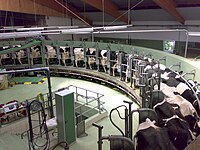
Photo from wikipedia
Divergence in opinion over how farm animals should be cared for is creating a disconnect between livestock farming and the public that risks a loss of “social license” to farm.… Click to show full abstract
Divergence in opinion over how farm animals should be cared for is creating a disconnect between livestock farming and the public that risks a loss of “social license” to farm. One proposed solution for the dairy farming community is to engage more constructively with the public to develop a shared vision of the industry's future; however, farmers and veterinarians remain reluctant to validate public opinions on farm animal care, in particular, often viewing them as naïve or impractical. Understanding the interpretive frames through which people make sense of dairy farming could help the dairy farming community engage more constructively with public opinion, thereby reducing conflict and providing opportunities to change communication or practice. Hence, frame analysis was conducted on transcripts of 60 face-to-face interviews with members of the UK public, first defining frames using reflexive thematic analysis, then considering the effect of these frames on those holding them. The results showed that dairy farming was mainly characterized by two entities: the cow and the farmer. Three frames were developed for the cow: she was perceived as i) enduring, which induced a sense of moral responsibility for her well-being among participants; ii) a fellow or companion, which led to feelings of a shared or parallel life with her; and iii) a force of nature, where the cow's connection with the natural world and “otherness” was appreciated, or even longed for. These connections were unexpectedly widespread within the sample, with many participants simultaneously holding two or even three frames. The farmer was seen through two frames: i) traditional; or ii) modernizing, but both frames had positive and negative narratives depending on the perceived care of the cow, causing confusion or even conflict about the care the farmer actually delivered. These findings provide new insights into the interpretive lenses through which the public makes sense of the dairy cow and her care, not least the bond the public themselves feel with the animal. They offer fresh opportunities for the dairy industry to improve engagement through more reflexive communication or modification of farming practices to better fit societal expectations about dairy cow welfare.
Journal Title: Frontiers in Veterinary Science
Year Published: 2022
Link to full text (if available)
Share on Social Media: Sign Up to like & get
recommendations!